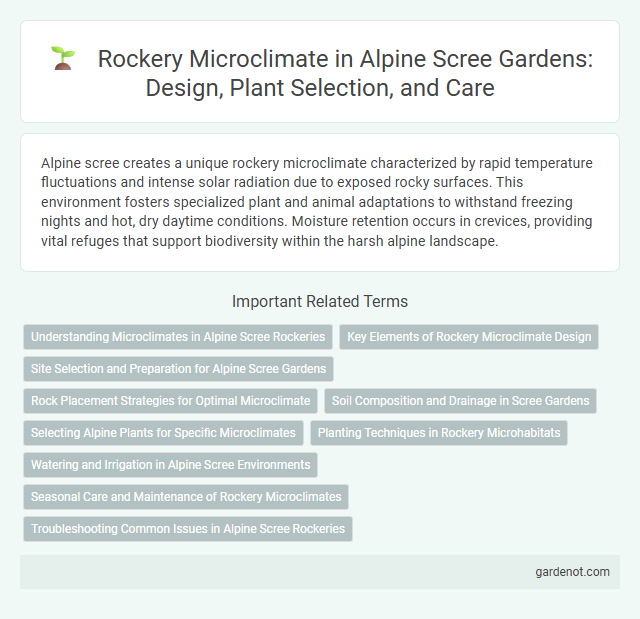Alpine scree creates a unique rockery microclimate characterized by rapid temperature fluctuations and intense solar radiation due to exposed rocky surfaces. This environment fosters specialized plant and animal adaptations to withstand freezing nights and hot, dry daytime conditions. Moisture retention occurs in crevices, providing vital refuges that support biodiversity within the harsh alpine landscape.
Understanding Microclimates in Alpine Scree Rockeries
Alpine scree rockeries create unique microclimates characterized by rapid temperature fluctuations, high solar radiation, and varying moisture retention. These microclimates influence species adaptation by providing niche habitats for specialized alpine flora and fauna. Understanding microclimate dynamics in scree slopes is essential for conservation and predicting ecological responses to climate change.
Key Elements of Rockery Microclimate Design
Key elements of rockery microclimate design include strategic placement of stones to maximize thermal mass, which moderates temperature fluctuations in alpine scree environments. Incorporating varied rock sizes and textures enhances moisture retention and provides refuge for alpine flora and fauna, fostering biodiversity. Orientation towards sun exposure plays a critical role in optimizing warmth and wind protection, crucial for sustaining sensitive plant species in harsh mountain conditions.
Site Selection and Preparation for Alpine Scree Gardens
Selecting an optimal site for an alpine scree garden involves choosing well-drained, sunny locations with rocky, slightly acidic soil to replicate natural scree environments. Proper preparation requires creating a layered substrate with coarse stones at the base and finer scree material on top to ensure excellent drainage and root aeration. Incorporating microhabitats such as crevices and varied rock sizes enhances temperature regulation and moisture retention essential for alpine plant survival.
Rock Placement Strategies for Optimal Microclimate
Strategic rock placement in alpine screes enhances microclimate regulation by maximizing solar heat absorption and creating sheltered niches for flora and fauna. Utilizing varied rock sizes and angular positioning optimizes thermal mass distribution, promoting moisture retention and temperature stability. Effective microclimate management through these techniques supports biodiversity and resilience in alpine scree environments.
Soil Composition and Drainage in Scree Gardens
Soil composition in Alpine scree gardens typically consists of coarse, well-draining substrates such as gravel, sand, and fragmented rock, which mimic natural scree environments and prevent waterlogging. Efficient drainage is crucial to support specialized alpine plants adapted to moisture fluctuations and to reduce root rot risk. This combination creates a microclimate that promotes aeration, rapid water runoff, and nutrient-poor conditions essential for rockery plant survival.
Selecting Alpine Plants for Specific Microclimates
Selecting alpine plants for specific rockery microclimates requires consideration of factors such as soil drainage, sun exposure, and wind protection. Hardy species like Saxifraga, Androsace, and Sedum thrive in well-drained, sunny scree environments, while moisture-loving plants such as Primula and Saxifrage prefer shaded or sheltered crevices. Matching plant species to precise microclimate conditions ensures optimal growth and resilience in alpine scree rockeries.
Planting Techniques in Rockery Microhabitats
Rockery microclimates create unique environmental conditions ideal for alpine scree plantings by mimicking natural rocky slopes with well-drained, nutrient-poor substrates. Effective planting techniques involve using hardy, drought-tolerant alpine species that thrive in crevices and shallow soils, optimizing exposure to sun and airflow while minimizing moisture retention. Strategic placement of plants with varying root depths and growth habits enhances soil stability and microhabitat diversity, promoting sustainable growth in rockery ecosystems.
Watering and Irrigation in Alpine Scree Environments
Watering in alpine scree environments requires careful management to mimic natural precipitation patterns and prevent waterlogging due to rapid drainage in rocky substrates. Drip irrigation systems are ideal for delivering consistent moisture directly to plant roots while maintaining the rockery microclimate's delicate water balance. Monitoring soil moisture levels and adjusting irrigation frequency is crucial to support drought-tolerant alpine species without disrupting the scree's unique hydrology.
Seasonal Care and Maintenance of Rockery Microclimates
Seasonal care of rockery microclimates involves monitoring temperature fluctuations and moisture levels to ensure optimal plant health in alpine scree environments. Regular maintenance includes removing debris, managing irrigation to mimic natural precipitation patterns, and protecting plants from frost or excessive heat. Adjustments in soil composition and the strategic placement of rocks promote drainage and thermal regulation crucial for sustaining diverse alpine flora throughout the year.
Troubleshooting Common Issues in Alpine Scree Rockeries
Alpine scree rockeries often face drainage problems that cause waterlogging, leading to root rot in sensitive alpine plants. Ensuring proper soil composition with coarse gravel and adequate slope can improve water runoff and prevent moisture accumulation. Monitoring for pests like aphids and slugs is essential, as these can quickly damage the delicate flora typical of alpine scree environments.
Rockery microclimate Infographic

 gardenot.com
gardenot.com